ISSN ONLINE(2319-8753)PRINT(2347-6710)
ISSN ONLINE(2319-8753)PRINT(2347-6710)
Tambe Prachi N 1, Dr. Dhande K. K. 2, Jamadar N. I3
|
| Related article at Pubmed, Scholar Google |
Visit for more related articles at International Journal of Innovative Research in Science, Engineering and Technology
Piping system is always need to be supported to prevent failure due to its self weight, operating pressure and temperature conditions etc. To decide the location and number of supports is very important as the wrong location of support may lead to failure of a whole system. This study is focused on the criterion of selection of piping support. The maximum span and deflection calculation is carried out and the piping system with intermediate support and without intermediate support is analysed in CAESAR II software. The two systems are compared and optimized the number of supports by considering the effect of support on nozzle loads and stresses.
Keywords |
| Support Location, Piping Support, Maximum support span, maximum deflection |
I. INTRODUCTION |
| Pipe supporting plays a vital role in designing a process plant. A pipe support is designed elements that transfer the load from the pipe to the supporting structures. The load includes the weight of pipe, the content the pipe carries, all the pipe fittings attached to pipe & the pipe covering such as insulation. The four main functions of a pipe support are to anchor, guide, absorb shock and support a specified load. Pipe supports used in high or low temperature applications may contain insulation materials. The overall design configuration of a pipe support assembly is dependent on the loading and operating conditions. |
| The basic types of supports can be as follows: |
| Sustained Loads: These are typically steady or sustained types of loads such as gravitational forces acting on the pipe such as weight of pipe and fluid, forces due to relief or blow down, pressure waves generated due to water/steam hammer effects. |
| Operating Loads: These are typically due to operating internal and external pressure. Expansion Loads: These are due to temperature differences in maximum operating and normal ambient temperature. |
II. RELATED WORK |
| Support span charts for various pipe sizes (DN 15-DN600) are provided by codes like ASME B 31.3 and ASME B 31.1. These spans are used as guidelines for pipe supporting. But the maximum span calculated using Bending Stress Theory is more with stresses in the allowable limit than the chart span value. This saves the number of supports and hence the cost [3]. Optimal pipe support span for geothermal pipe lines is calculated using code ASME B 31.1[4] |
III. PIPE SUPPORT LOCATION |
| The locations of piping supports are dependent upon four factors: pipe size, piping configuration, locations of valves and fittings, and the structure available for support. Individual piping materials have independent considerations for span and placement of supports. |
| Pipe size relates to the maximum allowable span between pipe supports. Span is a function of the weight that the supports must carry. As pipe size increases, the weight of the pipe also increases. The amount of fluid which the pipe can carry increases as well, thereby increasing the weight per unit length of pipe. The configuration of the piping system affects the location of pipe supports while valves require independent support. These items contribute concentrated loads to the piping system. Independent supports are provided at each side of the concentrated load. Location, as well as selection, of pipe supports is dependent upon the available structure to which the support may be attached. |
IV. PIPING SYSTEM SUPPORT DESIGN |
Pipe Data considered for design is: |
| Pipe Size: DN 1000 |
| Pipe Thickness: 6 mm |
| Pipe Material: A358 TP 304 |
| Max. Operating temperature: 1000c |
| Max. Operating Pressure: 0.28 bar |
| Fluid density: 0.42 kg/m3 |
| Ambient Temperature: 250c |
| Insulation Thickness: 70 mm |
| Insulation density: 120kg/m3 |
| Flange Rating: #150 |
| Flange Width: 164 mm |
| Flange Weight: 4546 N |
| Once the piping and fittings size, rating , thickness, material, operating conditions, Fluid density, insulation material is known, the support span calculation can be done using the usual beam formulas, which depend on the method of support and type of loading. [3] |
| Maximum Bending Stress, |
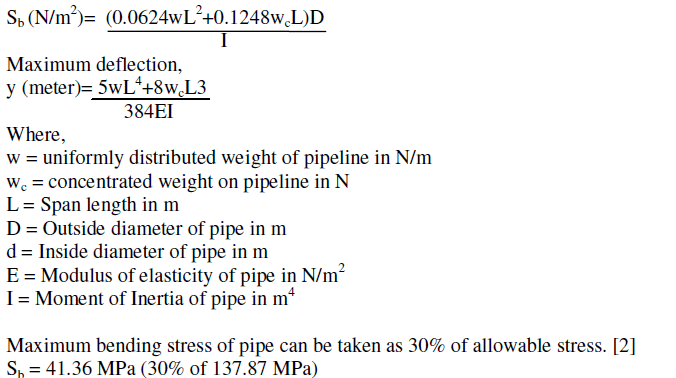 |
 |
V. PIPING SYSTEM WITH INTERMEDIATE SUPPORT |
| Consider a piping system with two anchors at end and intermediate support. |
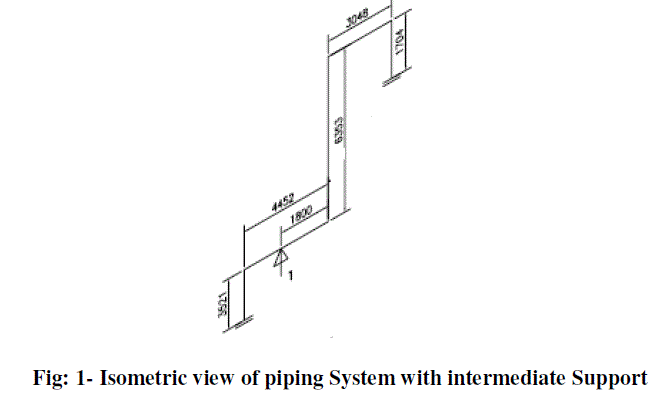 |
| The calculated values of maximum span and deflection are for straight run pipe. As the piping system considered consists of number of bends, the above criterion of maximum span shall not be applicable. As a general rule, intermediate support is considered immediately after bend after a large vertical distance [2] The piping system is modelled in CAESAR II software and following are the isometric drawing, displacement at various points, stresses and nozzle loads observed. |
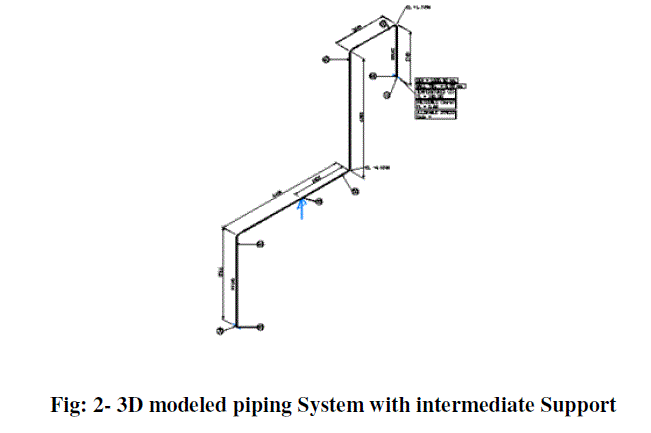 |
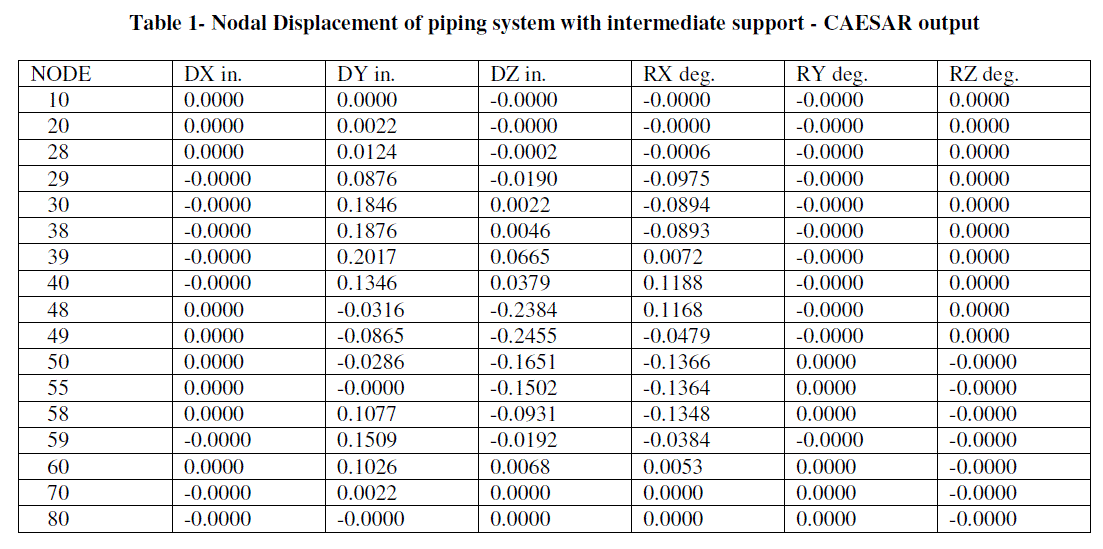 |
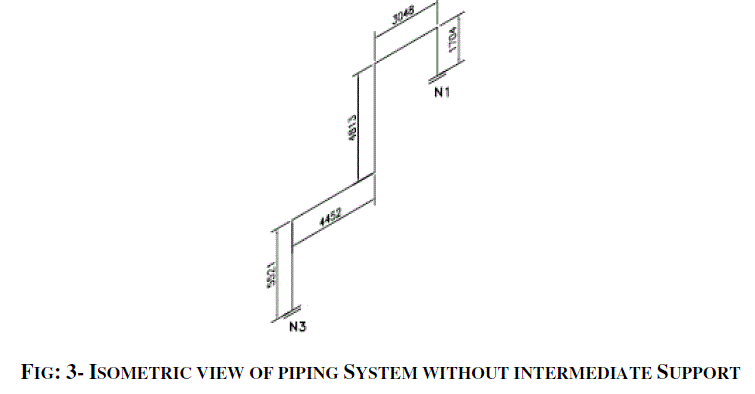 |
VI. PIPING SYSTEM WITHOUT INTERMEDIATE SUPPORT |
| Consider a piping system with two anchors at end and without intermediate support. Vertical distance is balanced as shown. N1 and N3 are the anchor points i.e the nozzles of equipment. |
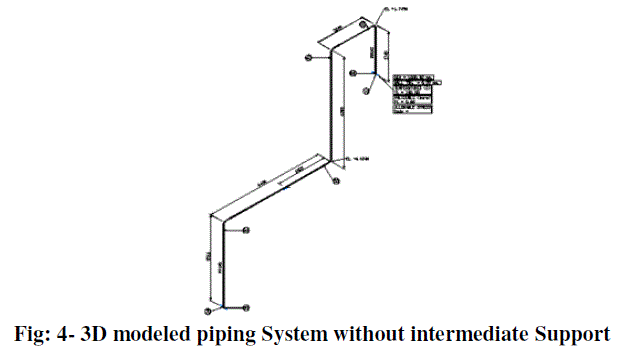 |
| Consider a piping system with two anchors at end and the vertical distance is balanced as shown. The system is modeled in 3D software CAESAR II without intermediate support. The vertical distance is varied in order to balance the stresses on the anchor points (Nozzles of the equipment.). Following are the isometric drawing, displacement at various points, stresses and nozzle loads observed. |
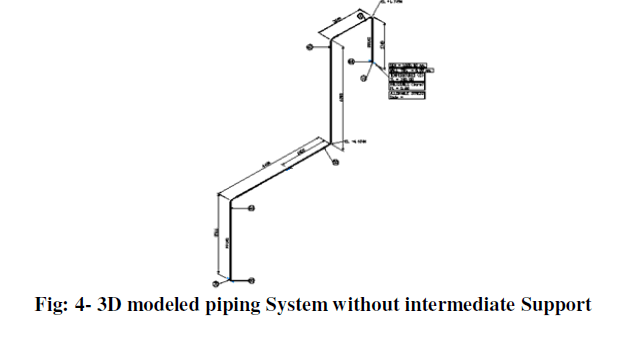 |
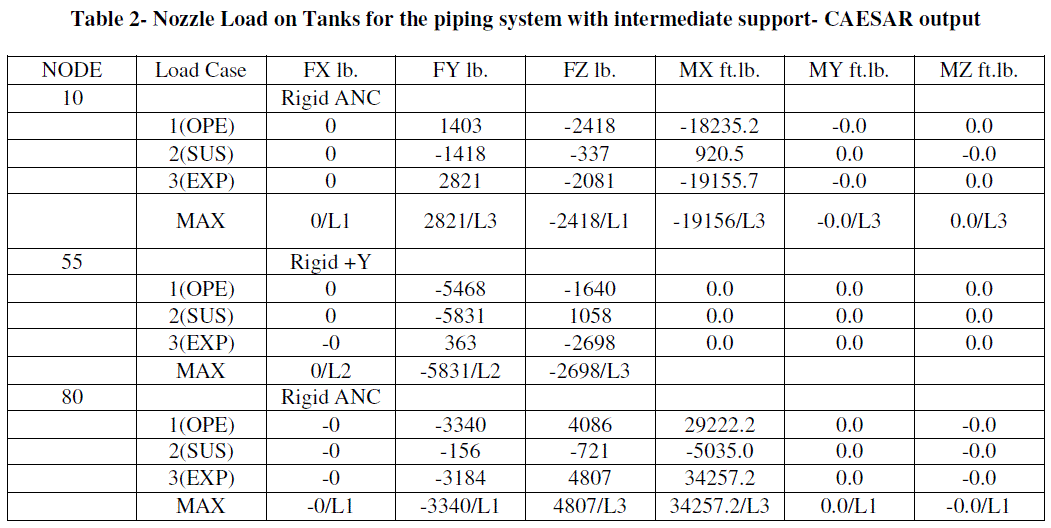 |
VII. RESULT |
| The maximum support span for the straight run pipe is calculated to 23.13 meters and maximum deflection of 23.6 mm. CAESAR II output for piping system with intermediate support and without intermediate support after balancing the vertical distance is observed. Code compliance evaluation for both the piping systems is passed i.e. the maximum stresses developed in the piping systems is less than the allowable stress mentioned by the process piping code ASME B 31.3. The code stress ratio is 19.1% for piping system with intermediate support and 25.3% for piping system without intermediate support. The maximum nodal displacement for piping system with intermediate support is 0.2455 inch (6.25 mm) and for piping system without intermediate support is 0.3689 inch (9.37 mm). The nozzle loads are tabulated for both piping systems. |
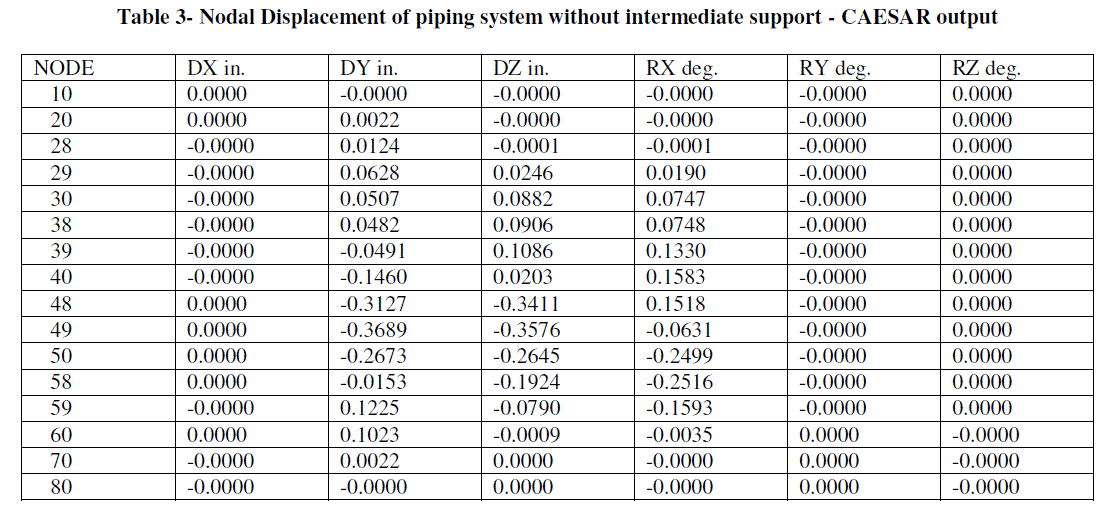 |
VIII. CONCLUSION |
| The analytical study of piping systems is done for maximum support span and maximum deflection of piping system. The maximum support span calculated analytically is 23.13 m and deflection calculated is 23.6 mm. This is for straight run pipe. |
| For complex systems with bends and other fittings, the system is modelled in 3D software CAESAR II. The software output -The nodal displacements, code compliance and Nozzle loads on connecting equipments are observed. When the software output is observed for these systems, the moment in X direction (Mx) for piping system with intermediate support is very high as compared to Mx for piping system without intermediate support. This may lead to failure of the system at nozzle (Node No. 80). To avoid the failure, intermediate support from this piping system is removed and the vertical distance is balanced. The software output shows drastic reduction in Mx at nozzle node No. 80. Though the load in Y direction is increased than the piping system with intermediate support, it is within safe limit. So piping system without intermediate support and by balancing the vertical distance is safer than the piping system with intermediate support. |
| The stresses developed in both the pipe system are in code stress limit and hence can be accepted. Unnecessary supporting creates a problem. This study reveals that the decision of location of support is very important with respect to the safety of piping system. |
References |
|